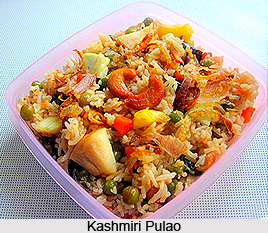 Kashmiri pulao also called `mixed rice` comes from the Northern Indian state of Kashmir. This delicious dish is popular for its rich aroma and sweet taste. Unlike other pulaos, lots of dry fruits and vegetables are added in this preparation making it nutritious and healthy. Kashmiri pulao is easy to make and can be prepared at home.
Kashmiri pulao also called `mixed rice` comes from the Northern Indian state of Kashmir. This delicious dish is popular for its rich aroma and sweet taste. Unlike other pulaos, lots of dry fruits and vegetables are added in this preparation making it nutritious and healthy. Kashmiri pulao is easy to make and can be prepared at home.
Ingredients of Kashmiri Pulao:
•2 cups long grain rice (basmati)
•2 cups milk
•Half cup cream beaten smooth
•1 tsp sugar
•Salt to taste
•Half tsp cumin seeds
•3 cloves
•1" cinnamon
•3 cardamoms
•1 bay leaf
•2 tbsp ghee
•1 cup canned chopped mixed fruit (drained)
•2-3 edible rose petals
Method of Preparing Kashmiri Pulao:
•Wash and soak rice for 15-20 minutes.
•Mix milk, cream, sugar and salt.
•Drain rice, keep aside.
•Heat ghee in a heavy pan.
•Add cumin seeds, cinnamon, bay leaf, cardamoms, and cloves. Allow to splutter.
•Add rice and fry in ghee for 2 minutes.
•Add milk, cream, and mixture.
•Add 1/2 cup water. Bring to a boil.
•When boil is reached, cover and simmer till cooked.
•Each grain should be cooked, but separate.
•Mix in drained fruit very gently.
•Garnish by sprinkling finely broken rose petals.
•Serve hot.
Another method of preparing Kashmiri pulao with slight change in the ingredients:
Ingredients of Kashmiri Pulao:
•1/2 kilogram basmati, cooked and drained
•3 tablespoons ghee or butter, to taste
•4 pods green cardamom
•1 cinnamon tree leaf
•2 green chillies split lengthwise
•1 1/2 teaspoons ginger-garlic paste
•50 grams pistachio nuts
•50 grams white raisins
•100 grams dried dates, pitted and sliced thin
•5 cloves
•50 grams cashew nuts
•50 grams almonds, blanched and diced
•1 small onion, sliced thin
•3-4 strands saffron
•1 tablespoon milk
•Pinch of salt
Method of Preparing Kashmiri Pulao:
•Firstly, heat ghee or butter in a large wide pan.
•Then, add all the dry spices including cloves, cardamom, and cinnamon tree leaf.
•Throw in the chopped onion and fry until it just begins to turn brown.
•Add ginger-garlic paste and chillies and fry for about 1 min before tossing in all of the dried fruits and nuts.
•Add salt to taste.
•Turn the flame down to low.
•Soak the strands of saffron in milk, mixing until the milk turns orange.
•Pour the cooked rice into the pan and sprinkle the saffron-milk on top.
•Stir carefully mixing the flavourings and saffron colour in uniformly and heating the rice.
•Add more ghee according to preference
•Serve hot
Kashmiri pulao does not require any side dish, due to its sweet taste it can be consumed alone. But those who are not comfortable eating this dish alone can opt for paneer butter masala, mutton curry, tadka dal, raita or anything as per preference.




















